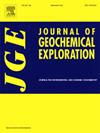Delineation of geochemical anomalies through empirical cumulative distribution function for mineral exploration
IF 3.4
2区 地球科学
Q1 GEOCHEMISTRY & GEOPHYSICS
引用次数: 0
Abstract
In this paper, a statistical outlier detection technique based on empirical cumulative distribution functions (ECOD) is applied to a multivariate geochemical dataset from southeastern Iran, which is known for its porphyry and vein-type copper mineral occurrences. The ECOD method assumes that outlier samples are situated in both the left and right tails of the cumulative distribution functions, and it determines whether the outliers are located in the right or left tails using the concept of skewness. Anomaly maps produced by the ECOD method are compared with those generated by the local outlier factor (LOF) method. Both ECOD and LOF are applied to two subsets, including 4 and 12 trace elements. The anomaly maps are evaluated by comparing the number of delineated known mineral deposits and using ROC curves. The result revealed that LOF was outperformed by ECOD in the delineation of known Cu mineralization and in the identification of zones containing mineralized samples collected during the anomaly checking stage. The ECOD anomaly map is also compared with results from the k-means clustering method, and the superiority of ECOD over k-means clustering is demonstrated. The implementation of ECOD on clr-transformed multivariate geochemical data shows promise but assumes statistical independence among features, often unmet in geochemical exploration. To address this, we transformed clr data into new principal and independent feature spaces using principal component analysis (PCA) and independent component analysis (ICA), enhancing anomaly detection efficiency. ECOD_ICA outperformed ECOD_PCA, successfully classifying all mineralized samples and 15 of 18 Cu mineral occurrences in the highest score class (Q4), as confirmed by ROC analysis. However, the reliance of the ECOD method on univariate tail probabilities limits its ability to detect multivariate anomalies arising from complex inter-element relationships. Strong correlations in geochemical datasets can lead to false positives, necessitating dimension reduction techniques. While PCA and ICA help manage these correlations, they may obscure meaningful signals. The ECOD outlier detection method is also sensitive to the skewness of the dimensions, so a careful feature selection stage is recommended before applying it. The method is less sensitive to the number of dimensions, which enhances its robustness. Additionally, the absence of hyperparameter tuning makes ECOD a reliable and efficient outlier detection method.
利用经验累积分布函数圈定地球化学异常在矿产勘查中的应用
本文将基于经验累积分布函数(ECOD)的统计离群值检测技术应用于伊朗东南部的一个多变量地球化学数据集,该数据集以斑岩和脉状铜矿赋存而闻名。ECOD方法假设离群样本位于累积分布函数的左尾和右尾,并利用偏度的概念确定离群样本位于右尾还是左尾。将ECOD方法生成的异常图与局部离群因子(LOF)方法生成的异常图进行比较。ECOD和LOF都适用于两个子集,包括4和12种微量元素。通过比较已圈定的已知矿床的数量和使用ROC曲线来评估异常图。结果表明,在已知铜成矿圈定和异常检查阶段采集的矿化带识别方面,LOF优于ECOD。将ECOD异常图与k-means聚类方法的结果进行了比较,证明了ECOD异常图优于k-means聚类方法。在clr变换的多元地球化学数据上实施ECOD显示了前景,但特征之间存在统计独立性,这在地球化学勘探中往往得不到满足。为了解决这一问题,我们利用主成分分析(PCA)和独立成分分析(ICA)将clr数据转换为新的主特征空间和独立特征空间,提高了异常检测效率。经ROC分析证实,ECOD_ICA优于ECOD_PCA,成功地将所有矿化样品和18个铜矿物点中的15个分类为得分最高的类别(Q4)。然而,ECOD方法对单变量尾概率的依赖限制了其检测复杂元素间关系引起的多变量异常的能力。地球化学数据集的强相关性可能导致误报,因此需要降维技术。虽然PCA和ICA有助于管理这些相关性,但它们可能会模糊有意义的信号。ECOD离群点检测方法对维度的偏度也很敏感,因此建议在应用之前进行仔细的特征选择阶段。该方法对维数的敏感性较低,增强了鲁棒性。此外,由于没有超参数调谐,ECOD是一种可靠、高效的离群值检测方法。
本文章由计算机程序翻译,如有差异,请以英文原文为准。
求助全文
约1分钟内获得全文
求助全文
来源期刊

Journal of Geochemical Exploration
地学-地球化学与地球物理
CiteScore
7.40
自引率
7.70%
发文量
148
审稿时长
8.1 months
期刊介绍:
Journal of Geochemical Exploration is mostly dedicated to publication of original studies in exploration and environmental geochemistry and related topics.
Contributions considered of prevalent interest for the journal include researches based on the application of innovative methods to:
define the genesis and the evolution of mineral deposits including transfer of elements in large-scale mineralized areas.
analyze complex systems at the boundaries between bio-geochemistry, metal transport and mineral accumulation.
evaluate effects of historical mining activities on the surface environment.
trace pollutant sources and define their fate and transport models in the near-surface and surface environments involving solid, fluid and aerial matrices.
assess and quantify natural and technogenic radioactivity in the environment.
determine geochemical anomalies and set baseline reference values using compositional data analysis, multivariate statistics and geo-spatial analysis.
assess the impacts of anthropogenic contamination on ecosystems and human health at local and regional scale to prioritize and classify risks through deterministic and stochastic approaches.
Papers dedicated to the presentation of newly developed methods in analytical geochemistry to be applied in the field or in laboratory are also within the topics of interest for the journal.
 求助内容:
求助内容: 应助结果提醒方式:
应助结果提醒方式:


